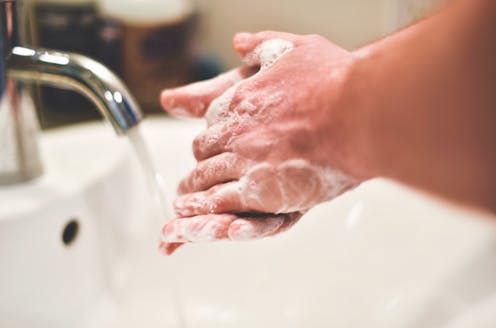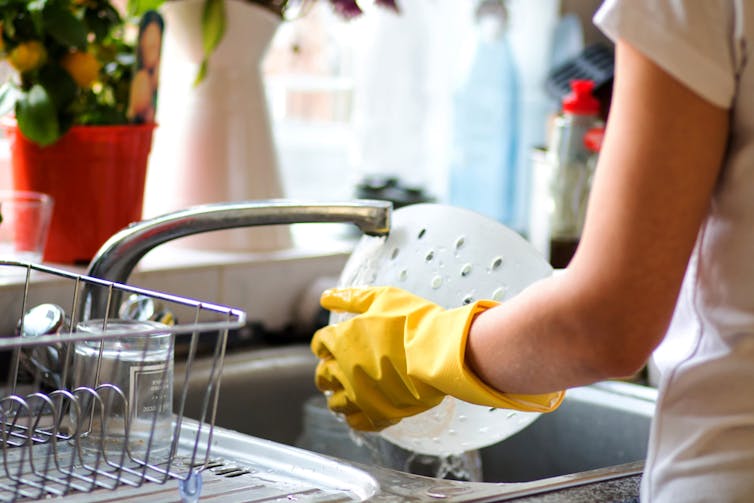My skin's dry with all this hand washing. What can I do?
- Written by Celestine Wong, Consultant Dermatologist, Monash Health

Washing your hands is one of the crucial ways we can all help limit the spread of COVID-19.
Regularly and thoroughly washing your hands with soap and water for at least 20 seconds, or using an alcohol-based hand sanitiser, are key steps to reducing the risk.
But with all this hand washing, it’s easy to get dry skin or for existing skin conditions to flare up.
Read more: Yes, washing our hands really can help curb the spread of coronavirus
What’s happening to our skin?
The top layer of our skin (the stratum corneum) is our skin’s key protective layer. But frequent hand washing with repetitive exposure to water, soap and skin cleansers will disrupt this layer.
Over time, this leads to dry skin, further disruption of the skin barrier and inflammation.
This eventually results in hand dermatitis, or more specifically, irritant contact dermatitis.
Who’s more likely to have problems?
Irritant contact dermatitis is more common in people who perform “wet work” as they wash and dry their hands many times a day.
They include health-care workers (doctors, nurses, personal care assistants), hairdressers, food handlers, kitchen staff and cleaners. They may also be exposed to irritating skin cleansers and detergents.
But now handwashing is becoming more frequent during the COVID-19 pandemic, there may be more affected people outside these occupations.
 Health-care workers, who wash their hands multiple times a day, are particularly at risk of hand dermatitis. Shutterstock
Health-care workers, who wash their hands multiple times a day, are particularly at risk of hand dermatitis. Shutterstock
People with eczema, asthma and hay fever are also at higher risk of developing irritant contact dermatitis or experiencing a flare of underlying eczema.
Read more: Common skin rashes and what to do about them
How do I prevent hand dermatitis?
1. Soap, soap alternative or hand sanitiser?
People with eczema or who have had contact dermatitis before will have more easily irritated skin. While they can still use hand sanitisers, it’s recommended they wash with gentler soap-free washes rather than normal soap.
Soap-free washes contain non-soap-based synthetic detergents (syndets). Syndets have a nearly identical cleansing action as soap, but with the benefit of having the same pH as the skin. This means they’re less likely to remove the oils from the outer layer of the skin and are less irritating.
Soaps have a high pH and are quite alkaline. This disrupts the outer layer of the skin, allowing the soap to penetrate deeper into the skin, thus causing more skin irritation and itching.
Other people who don’t have eczema or a history of contact dermatitis should just use soap. Liquid soaps usually contain fragrances and preservatives, which can cause another type of dermatitis (allergic contact dermatitis), so opt for a plain, unperfumed bar soap.
2. Dry your hands thoroughly
Dry your hands thoroughly, including the webs of your fingers and under your rings to reduce dermatitis caused by trapped water. Skin irritation and breakdown can occur when there is excessive moisture, soap residues and water trapped between the skin and underneath rings.
Read more: Coronavirus and handwashing: research shows proper hand drying is also vital
3. Use non-fragranced moisturiser regularly
Moisturisers come in different formulations. While lotions are light in consistency and convenient to use during the day, they will require more frequent applications. Creams and ointments have thicker and oilier texture, are effective for dry hands and are best used overnight.
Fragrances can cause allergic contact dermatitis and are best avoided, where possible.
4. Use alcohol-based hand sanitiser (if you can get hold of it)
Alcohol-based hand sanitiser will reduce your skin’s contact with water, and so lower your risk of dermatitis.
Research in health-care workers shows hand sanitisers cause less contact dermatitis than washing with soap and water.
Sometimes people wrongly believe that when hand sanitiser stings on a paper cut, this means that they are allergic. But this is an irritant reaction and though uncomfortable, it’s safe to keep using it.
Which sanitiser? This usually comes down to personal preference (and what you can get hold of).
5. Use gloves
Use protective gloves when doing household chores, such as washing the dishes or when gardening.
Use cotton gloves when doing dry work, such as sweeping or dusting, to protect your hands and minimise the need to wash them.
 Use washing up gloves where possible. Shutterstock
Use washing up gloves where possible. Shutterstock
At night, moisturise your hands than wear cotton gloves. This acts like an intensive hand mask and works wonders for very dry skin. It ensures the moisturiser stays on your hands and increases its penetration into your skin.
What if my hands are already damaged, dry or cracking?
1. Act early
Treat hand dermatitis as soon as it occurs, otherwise it will get worse.
2. Apply petroleum jelly
If you think you’ve lost your nail cuticle (the protective barrier between the nail and nail fold), water will be able to seep into the nail fold, causing swelling and dermatitis.
Use petroleum jelly, such as Vaseline, as a sealant to prevent further water damage. Petroleum jelly can also be used on skin cracks for the same reason.
3. Seek medical help
If there are any red, dry and itchy areas, indicating active dermatitis, seek help from your GP or dermatologist.
They can start you on a short burst of an ointment that contains corticosteroids until the rash subsides.
Prescription ointments are likely to be more effective than over-the-counter creams because of their higher potency.
But you could start with buying 1% hydrocortisone ointment, not cream, from the chemist.
Read more: What can you use a telehealth consult for and when should you physically visit your GP?
Sometimes dermatitis can become infected with skin bacteria such as Staphylococcus aureus. Seek medical advice if you experience symptoms such as persistent soreness or pain.
You should also seek medical help if you have severe hand dermatitis not responding to home treatments.
Most GPs and dermatologists are moving to or have started using telehealth so you can consult them using a video call, minimising face-to-face appointments.
Authors: Celestine Wong, Consultant Dermatologist, Monash Health
Read more https://theconversation.com/my-skins-dry-with-all-this-hand-washing-what-can-i-do-134146





